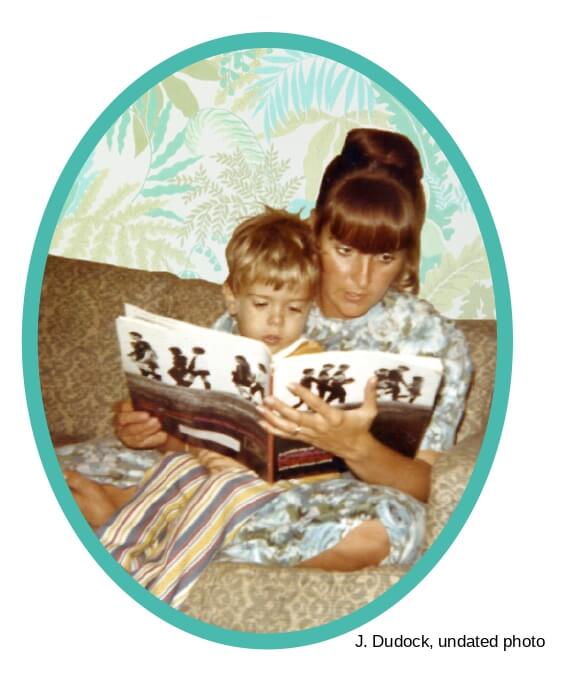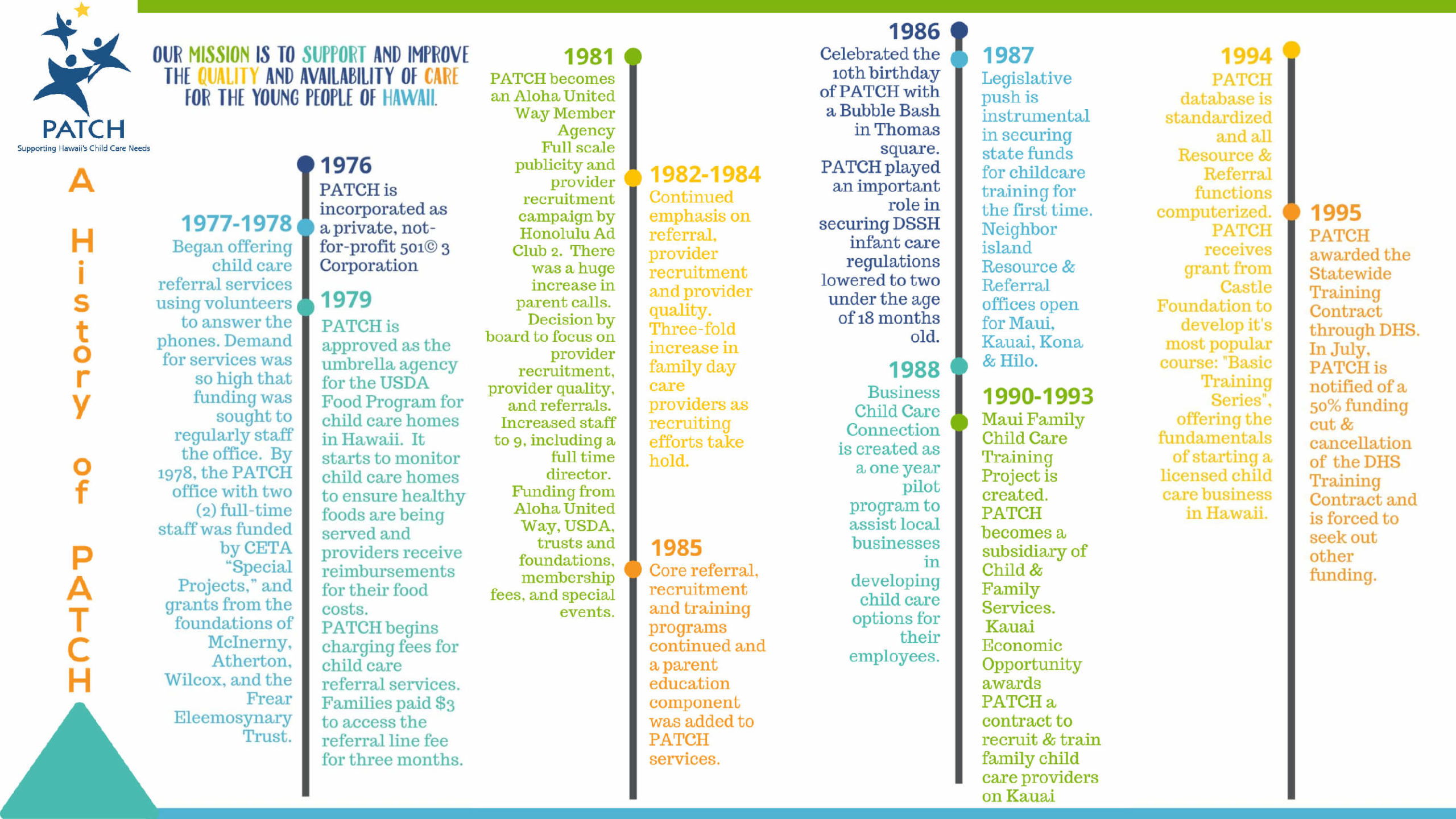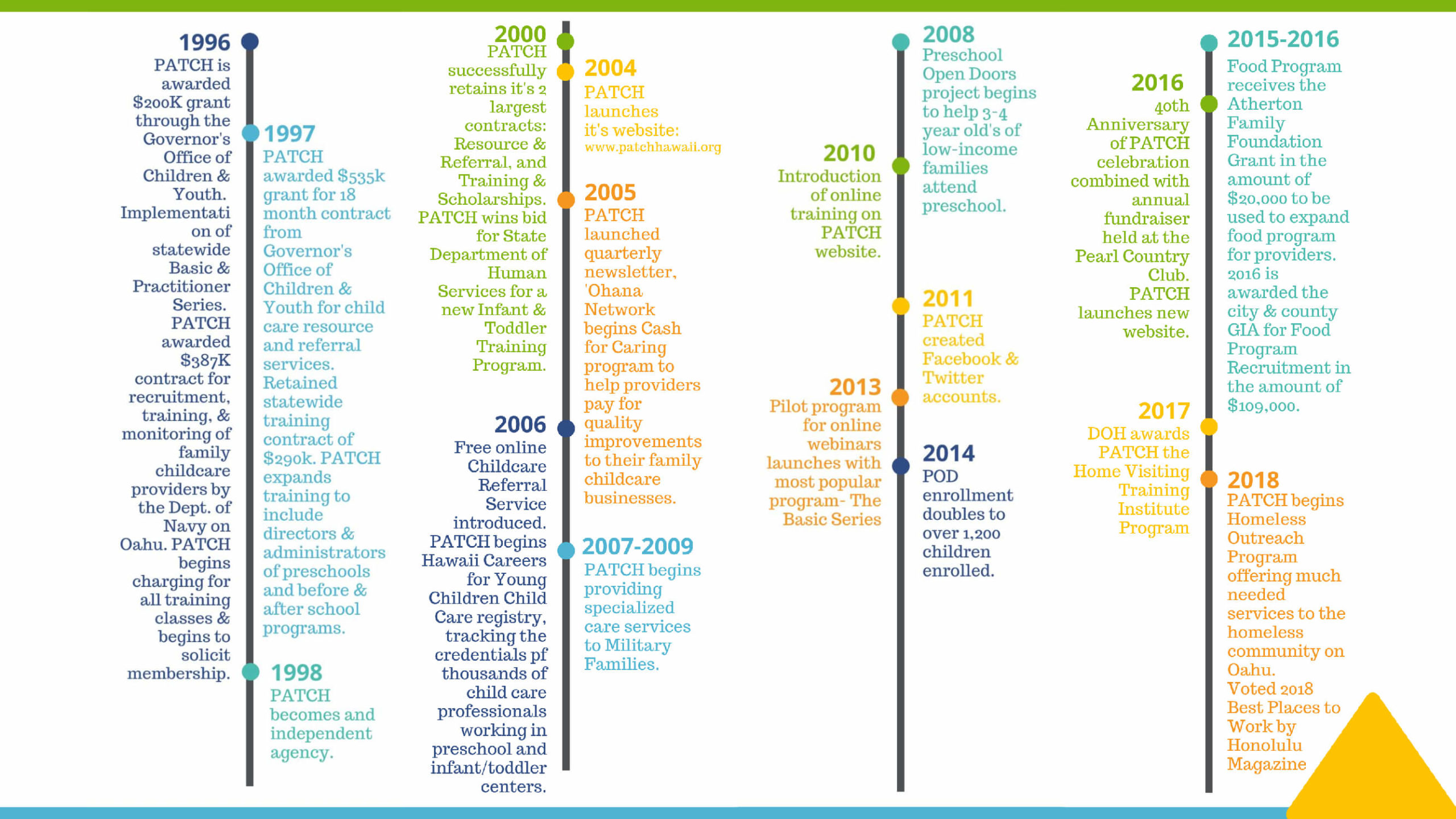Our Story

PATCH: A Labor of Love
This piece was written by Jackie Dudock in March of 2016 to commemorate PATCH’s 40th Anniversary
During the late 1960’s and early 1970’s, I was a young mother who had just realized our household needed a second income. I had degrees in Education and Psychology so there were options. I loved being a mom and had a serious interest in providing the best experiences possible during the earliest years for my child. A search for a care situation outside of my home was actually discouraging, even frightening at times. On a visit to one facility, I approached the fence surrounding a dusty, open area of red dirt. Clinging to the gate were four small keiki in underwear, tear stains on dirty little faces. They reached out, holding on to my skirt as I made my way up the cracked cement walk, toward a smiling, attractive, pregnant young woman. As I approached her, I noticed one of my companions had a strong odor and his BVDs were full and hanging low. I laughed a little and said, “it looks like this little guy needs a change.” “We don’t do that here”, she replied, “they’re supposed to be toilet trained.”
That was a day that changed my life and set my career on an unanticipated course of working toward ensuring optimal quality in Early Education Programs.
I learned that the conditions I encountered were not an anomaly. Any care was a challenge to find. The only legal option for the care of infants was in private homes. Many of those homes operated underground, unlicensed, often over crowded. The Rules Governing Child Care focused only on facilities and basic sanitation and safety. Once licensed, there were seldom follow up visits due to shortages of licensing workers.
During this period, Hawaii had no regular early childhood training. There was one Professor at the University of Hawaii, whose heart was in Early Education, but because the DOE did not receive children under five, there was no demand for teachers of young children. No Community Colleges.
A fledgling Hawaii Association for the Education of Young Children (HAEYC) gave workshops sporadically and Chaminade University offered summer workshops for teachers of children 3-6years old.
Although I continued to familiarize myself with options and ask questions, I knew I provided the best available option for the care and education of my son. It was daunting to think of being responsible for the children of others on a continuous basis, it helped to think of the situation as providing playmates for him. I posted a colorful collage of children engaged in creative activity on supermarket bulletin boards and at the University of Hawaii. The response was immediate and overwhelming. Many more families than I could help contacted me. They were desperate and willing to drive to my home in Kaimuki from all corners of Oahu. We settled in with four friends for my son. Thus began our Early Education. The calls kept coming. Visitors came to see what we were doing. The “coconut wireless”-Hawaii’s social media connection before cell phones, computers, and Facebook had connected me with parents, professors, and potential care providers. With a lot of encouragement, I took a side journey to start a school. It was to become the first nationally certified Montessori preschool in Hawaii.
At the same time, I was introduced to Marion Rausch, who had just completed her PhD project, determining whether training had a lasting effect on the practice of in home childcare providers. The answer was yes, but even more important to the care of children, was ongoing in-service training and support for the provider. There were family care providers from Marion’s project that wanted to continue with some sort of mentoring. By this time, I had another baby and was determined to have her with me during her early years. We met with family care providers, their friends, professionals in Education, Health and Human Services professionals, and a few very motivated parents of infants, to discuss issues and strategize a way to shift the way family child care was regarded, improve the quality of care, and prepare the infrastructure to support it.
Probably the single most important task at that time was to have a section on program quality included in the rules governing childcare. The rules were due to be revised and we made sure to have a spot on the committee. Some were leery of making it more challenging to provide care since so many providers were operating underground but without at least a minimum standard for interacting with children there was no direction or accountability.
Next in importance was training, to provide a consistent curriculum that was accessible to providers and relevant to their role in the lives of children, delivered in a nonthreatening way. Initially, training in workshop format was provided in homes of willing care providers, or in parks, with participants from the same area, to encourage relationships among providers. These sessions were offered at no cost to caregivers. Trainers volunteered their time. Two of us had babies, which added to our credibility in the eyes of the caregivers. Potluck suppers and snacks added to the comfort level.
Training included business practices, record keeping, child assessment, as well as all aspects of child development and activities for children. All of the training and social gatherings were designed for success in order to boost the self-esteem of caregivers and give them confidence to take their education further. Eventually, Honolulu Community College (HCC) brought the trainers on as “casual hires” who were paid per training.
The first attempts to connect caregivers and parents was handled by volunteers. The number of parents needing care, always was greater than the available caregivers.
When the warm line became overwhelming, a paid position was funded. A start up grant was secured to set up an office and a Director was hired to move the organization to the next level. The first Director, Ann Zavitkovsky was the daughter of an NAEYC President which drew us into the national arena as participants in formulating Developmentally Appropriate Practice and CDA Credentialing.
The success of PATCH and it’s wide acceptance in the community was related to the power of the message that the earliest years are the most critical in a child’s development. Their experiences and interactions with others have an indelible impact on the people they become. The lives of young children are important and those who care for them and guide their growth are important.

PATCH was able to shed light on the unacceptable conditions of early care and education and provide a solution by drawing on the skills and abilities of those who were accomplished, to raise the practice of those who needed to change and by educating parents and the broader community to recognize the elements of appropriate care.
During those early years of organizing people from various agencies and diverse backgrounds rallied in support of our youngest citizens and their caregivers with an absence of competition. Their strong interest and cooperation made the task of raising the quality and expanding the options for families possible. It set a tone for the interactions of parents and providers and for caregivers to look beyond their front porches to learn and grow.
It is thrilling to overhear a conversation about brain connections and synapses at Starbucks or to see posts on Facebook about ways to enhance a child’s growth. With the internet a whole new option for learning exists for all of us. The standards of care and early education have risen. There is a new set of challenges to be met. What hasn’t changed is the need for nurturing relationships at home and in the workplace. For those whose work is caring for children in their homes,support and encouragement is imperative. Nurturing and bringing people together is a thing at which PATCH excels, or in other words creating a foundation for family life.
History Timeline


